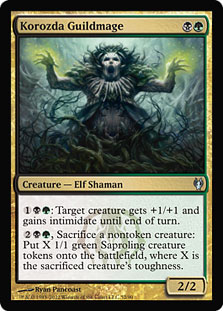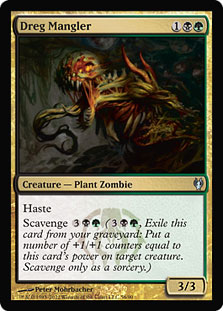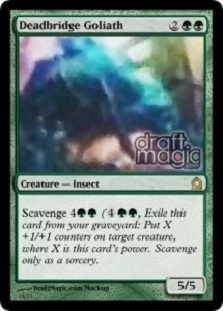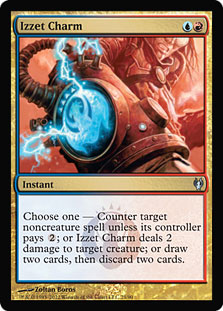Many of us have fond memories of Ravnica. For some of us, it was the most fun Limited format Wizards ever produced, and for others of us, it was simply the powerful and enjoyable Block Constructed and Standard archetypes that ‘got us going.’Â
Wizards is aware of these fond memories, and to those of us who are worried that the new set won’t live up to expectations, I humbly suggest:
I don’t think Wizards would risk revisiting Ravnica unless they know that the set will be a tremendous success.*
Through the Izzet vs. Golgari Duel Decks, we’ve already begun to get a picture of the new mechanics in the set. Even though we haven’t seen any truly splashy rares or mythics yet, it’s looking like it Return to Ravnica is a fairly powerful set, at least in concept.
It’s risky to develop new archetypes for an upcoming Standard format without context though. Many of us make the mistake of seeing a new card and jamming it into an existing deck while ignoring the other 225+ cards that will also exist in that format.
What we can do, though, is look at archetypes thematically and see where new cards and cards like them (i.e., those that share a mechanic) might effectively fit.
Golgari + Scavenge
We begin with the preponderance of the cards spoiled, which are Golgari / scavenge cards. I’m willing to go on the record now and bet (along with a few others, I’ll wager) that scavenge will be a Standard viable strategy. Abstractly, one of the weakest aspects of the ‘creature’ subtype is the inability of most creatures to alter the game outside of combat. Scavenge adds utility to a whole class of creatures and, similarly to unearth, allows them to strike again.
Importantly, though, scavenge has the ability to be more modular than unearth. If we unearth a Dregscape Zombie, it doesn’t do anything unless a 2/1 creature is able to make it through the red zone. With scavenge, we can apply counters to a creature of our choice (i.e., Geist of Saint Traft), making it more likely that our play is meaningful. We also can gain benefits from using scavenge on a turn that isn’t the one on which we paid the mana cost.
One of the first areas where we might look for synergy is the Innistrad Block Constructed ‘Jund’ style decks, many of which would play very cooperatively with these new cards.
Typical decks in this vein use cards like:
Falkenrath Aristocrat
Huntmaster of the Fells
Zealous Conscripts
Bonfire of the Damned
Devil’s Play
Garruk Relentless
Sever the Bloodline
Borderland Ranger
Tragic Slip
Wolfir Silverheart
Abundant Growth
At first glance, these decks simply look like Jund-colored Junk decks, with a lot of good cards in those colors smashed together for value. In fact, this is, to some extent, the essence of the decks. However, if we conceptualize how scavenge and Golgari cards might operate in such a deck, as well as M13 standouts, we can begin to form a more aggressive strategy with a lot of utility, more in the vein of Jund decks from Alara block.
1) Utilizing ways to sacrifice creatures for value + scavenge.
Cards like Falkenrath Aristocrat and Garruk Relentless gain a lot of value when paired with a card like Dreg Mangler. If we make the moderate (but not unreasonable) assumption that shocklands will be reprinted and that we’ll get a one-drop mana accelerator that isn’t Avacyn’s Pilgrim (honestly, Arbor Elf is fine if we have shocklands), then we have the ability to come out of the gates quickly.
Turn 1: Accelerator
Turn 2: Dreg Mangler (attack for three)
Turn 3: Falkenrath Aristocrat (attack for seven)
Rather than playing a bunch of Goblins and emptying our hand to attack for seven on the third turn, we’ve used only a few cards, each of which can affect the game in ways other than by attacking (i.e., playing Garruk Relentless and sacrificing Dreg Mangler to Tutor up another creature, then Scavenging to pump the Falkenrath Aristocrat). Attacking aggressively while also retaining a variety of potential lines of play is a meaningful hallmark of an effective archetype.
b) Playing Korozda Guildmage (or cards like it) and Hellrider.
Another way that we might effectively develop an aggressive Jund deck is by pairing Korozda Guildmage, not an unreasonable attacker in its own right, with a card like Hellrider. Being able to deploy a card like Deadbridge Goliath or even (again) Dreg Mauler, sacrifice it as needed for tokens, and then get Goblin Bombardment like value from those tokens is a powerful strategy, especially if we can Bonfire away some blockers.
c) Cards like Flinthoof Boar and Crimson Muckwader go up in value a lot if shocklands are reprinted.
d) Lets not forget that Rancor is a card when assessing things like Deadbridge Goliath and Dreg Mangler.
Rootborn Defenses + Populate
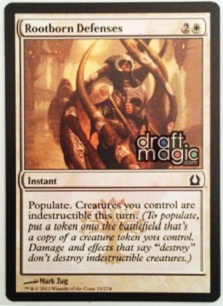
Now that Rootborn Defenses has been confirmed as an official card, we know that populate will be the Selesnya mechanic. Our first thought upon seeing this card, in particular, was probably Geist of Saint Traft.
As a relatively fragile 2/2 (hexproof notwithstanding), Geist of Saint Traft is at its best when blockers have been cleared out of the way (thanks Vapor Snag!). In the event that a Geist centric deck emerges even after Delver loses most of its key components, the ability to copy the 4/4 Angel token, keep it around, and save the Geist for another attack step makes Rootborn Defenses seem good, if gimmicky.
This card, more so than the scavenge cards, is very difficult to assess outside of the context of the rest of the set. Aside from a 4/4 Angel token, what are we really copying? Is a card that reads "make a 1/1 flying Spirit token, your creatures don’t die to Bonfire of the Damned" actually better than Safe Passage (which sees no Constructed play)?
The jury still seems to be out here.
Izzet True? Could Delver Still Be Viable?
Sometimes, perhaps often, all it takes is one or two cards of a specific type to push an archetype from fringe playable to viable. The high level of utility presented by Izzet Charm suggests that something like U/R Delver or RUG Delver might very well be a reality even after the Standard rotation removes many of its current weapons. Without knowing much about how Izzet works yet as a guild (aside from overload), we know that it is a guild that notoriously has effective blue, red, and blue/red spells.
I don’t imagine that we should envision running four copies of Negate in a deck like Delver, which often has eschewed even a full set of Mana Leak, a much more efficacious counterspell against an unknown opponent. However, the modality of Izzet Charm makes it an easy card to include in multiples. It can function as a Miscalculation / Negate hybrid, a removal/burn spell, or the first half of Faithless Looting. There are few situations in which it is actively bad to draw this card.
Accounting for Izzet Charm, let’s examine just how easy it would be to redevelop Delver. All that needs to happen is that Return to Ravnica has to contain another one or two good, Constructed playable, and cost relevant blue and red spells (assuming, of course, that Return to Ravnica leaves a place in the metagame for this kind of deck).
It’s worth noting that this Delver will be a different animal in some regards because there won’t be a high volume of free spells that can fuel the early game in conjunction with Snapcaster Mage. We’ll have to move from nineteen or twenty lands to something like 22 or 23 lands, and we’ll look a bit more like an aggro-control deck than a Fish deck.
Imaginary U/R Delver
4 Delver of Secrets
4 Snapcaster Mage
2 Augur of Bolas
3 Talrand, Sky Summoner
1 Thundermaw Hellkite
4 Izzet Charm
3 Bonfire of the Damned
4 Unsummon
3 Thought Scour
3 Pillar of Flame
7-8 Return to Ravnica cards
4 Sulfur Falls
4 Steam Vents (?)
2 Evolving Wilds
6 Island
3 Mountain
2 Cavern of Souls
1 Desolate Lighthouse
Obviously, we’re limited in terms of deck design because we not only don’t know what can be included in our deck, but we also don’t know what could be in our opponent’s deck! For those reasons alone, this doesn’t even constitute a rough draft of a deck. What it does illustrate, however, is that if the opportunity arises, Delver of Secrets might once again grab the reins in Standard.
Even with only eight cards having been spoiled in the upcoming set, I’m already getting excited for September’s Prerelease!
* There’s always the risk that something will go wrong, of course. I don’t think anyone expected Diablo 3 to ‘fail’ as spectacularly as it did after the successes of Diablo 2.

